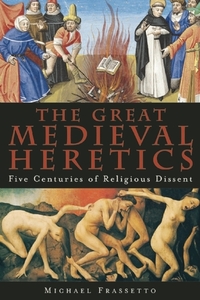Take a photo of a barcode or cover
lostsoul's review against another edition
challenging
dark
informative
reflective
tense
slow-paced
3.0
Graphic: Body horror, Death, Genocide, Fire/Fire injury, and Classism
Most of the triggers are because of the heretics during the crusades. This book is far from gorey, but it's very informative.ajmaese's review against another edition
5.0
I liked this book much more than I thought I would. I found it very easy to read and engaging.
*** The following paragraphs are my thoughts and opinions based off of the material in the book.
It can be said that there were two strands of 'heresy' during the mid to high middle ages. The first strand consisted of those who repudiated orthodox doctrines, including the dualist Bogomils, docetic Cathars, mystic Beguines, and militant millenarians (like Segarelli and Fra Dolcino). The second strand were of those who did not deny orthodox doctrines per se but in some way supplanted the authority of the Roman Church by their teachings. Valdes of Lyon, John Wycliffe, and Jan Hus are within this strand. Attacks upon 'heretics' were often politically motivated, brutal, and sometimes unjustified even within the context of the time. The hypocrisy of a church that would condemn Valdes of Lyon but acquiesce to Francis of Assisi, burn Jan Hus on the pyre for preaching reform during the atrocity of the Avignon papacy, and use the Albigensian Crusade to political ends are examples of the political calculation behind many of the actions of the Roman Church during the middle ages. In my opinion, those of the first strand of heresy were perhaps rightly condemned while those of the second not necessarily so. Indeed many reform minded individuals were operating within the Roman Church, such as the monks of Cluny (Peter the Venerable) and of Clairvaux (St. Bernard).
In many ways, the drive to reform the church was already present in the middle ages and the beliefs and actions of medieval 'heretics' prefigured events of the 16th century. Many sought to recover the 'apostolic life' of poverty and chastity and condemned the 'worldliness' of the Roman Catholic clergy in the practice of simony and indulgences. The nature of the eucharist was also called into question as transubstantiation was oft used to validate the Roman Catholic priesthood. A clear distinction began to form between those who would turn to the Scriptures as the ultimate authority and seek to establish themselves within the Christian tradition of earlier centuries and those who would seek to establish their own authority apart from Scripture and orthodox Christian tradition.
*** The following paragraphs are my thoughts and opinions based off of the material in the book.
It can be said that there were two strands of 'heresy' during the mid to high middle ages. The first strand consisted of those who repudiated orthodox doctrines, including the dualist Bogomils, docetic Cathars, mystic Beguines, and militant millenarians (like Segarelli and Fra Dolcino). The second strand were of those who did not deny orthodox doctrines per se but in some way supplanted the authority of the Roman Church by their teachings. Valdes of Lyon, John Wycliffe, and Jan Hus are within this strand. Attacks upon 'heretics' were often politically motivated, brutal, and sometimes unjustified even within the context of the time. The hypocrisy of a church that would condemn Valdes of Lyon but acquiesce to Francis of Assisi, burn Jan Hus on the pyre for preaching reform during the atrocity of the Avignon papacy, and use the Albigensian Crusade to political ends are examples of the political calculation behind many of the actions of the Roman Church during the middle ages. In my opinion, those of the first strand of heresy were perhaps rightly condemned while those of the second not necessarily so. Indeed many reform minded individuals were operating within the Roman Church, such as the monks of Cluny (Peter the Venerable) and of Clairvaux (St. Bernard).
In many ways, the drive to reform the church was already present in the middle ages and the beliefs and actions of medieval 'heretics' prefigured events of the 16th century. Many sought to recover the 'apostolic life' of poverty and chastity and condemned the 'worldliness' of the Roman Catholic clergy in the practice of simony and indulgences. The nature of the eucharist was also called into question as transubstantiation was oft used to validate the Roman Catholic priesthood. A clear distinction began to form between those who would turn to the Scriptures as the ultimate authority and seek to establish themselves within the Christian tradition of earlier centuries and those who would seek to establish their own authority apart from Scripture and orthodox Christian tradition.
